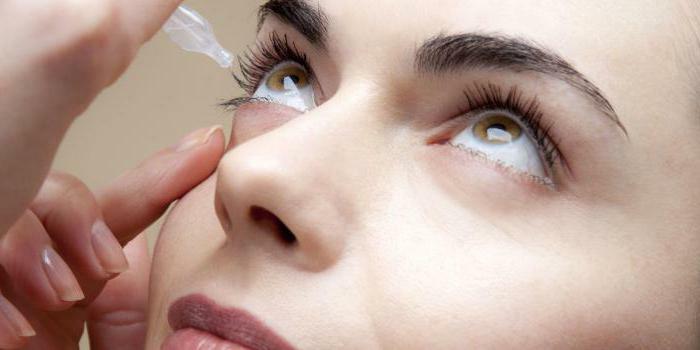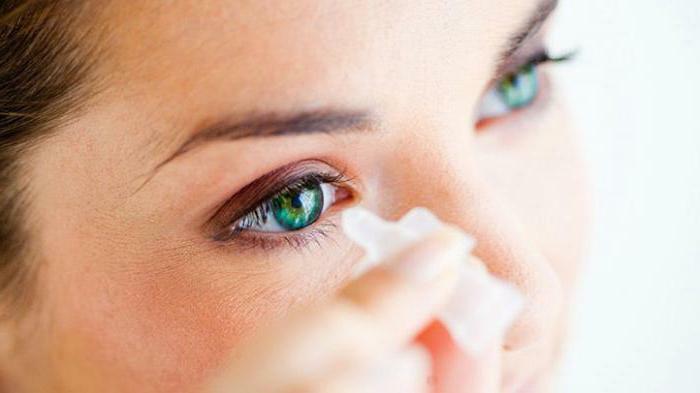Eye drops "Azidrope": instructions for use, indications, composition, reviews
"Azidropom" refers to eye drops used in ophthalmology for the therapy of conjunctivitis. With topical application, they have an effective antibacterial effect.
Composition and form of the release of "Azidrope"
According to the instruction, eye drops "Azidrop" are produced in the form of an oily colorless liquid, having a clear to light yellow color. In 1 gram of the drug contains 15 mg of the main active substance - azithromycin dihydrate and up to 1 g of auxiliary components in the form of triglycerides of mid-kidney.
The drug is available in the form of single-use vials of 0.25 g volume, consisting of high-density polyethylene, which are welded together into 3 or 6 pieces of tape packed in packs of cardboard.

Pharmacological action of eye drops
According to the instructions, eye drops "Azidrop" are an antimicrobial drug for topical use. Azithromycin is an antibiotic of a wide spectrum of the second generation of macrolides and azalides. Slows down the process of protein synthesis of bacteria, by binding to the large 50S subunit of the most important non-membrane organelles of the cell - ribosomes, and also prevents the translation of peptides.
The mechanism of antibiotic resistance
There are three mechanisms of resistance of various bacteria to the action of macrolides: predetermined by modifying the purpose of the action, modifying the antibiotic or by actively releasing the antibiotic from the bacterial cell due to the active excretion of "Azidrope."This transport system( efflux) important for streptococci is encoded by a mef-gene localized on the chromosome and leads to limited resistance of macrolides. Modification of the goal of the action, controlled by MLSB-phenotype, leads to cross-resistance antibiotic resistance.
Treatment of conjunctivitis in adults should be comprehensive.
There are cases of cross antibiotic resistance to azithromycin, erythromycin and other macrolides. In other words, the drug is not active against microorganisms resistant to the above antibiotics.
Description of eye drops "Azidrop" is detailed in the annotation. 
Pharmacokinetics
After the "Azidrop" in the recommended dose is drenched in the eye to treat bacterial conjunctivitis, azithromycin will not be detected in the blood of patients.
Indications for use
As indicated in the manual, eye drops "Azidrop" are used to treat conjunctivitis caused by drug-sensitive microorganisms:
- bacterial conjunctivitis, which has purulent-mucous discharge in children and adults( from birth to adulthood);
- trachoma, which is caused by Chlamydia trachomatis( trachomatous conjunctivitis) in children and adults( from birth to adulthood).
Dosage regimen of the drug
Adults with eye injuries should be instilled in the conjunctival sac one drop twice a day( morning and evening, respectively) for three days.
For people of advanced age and children, the dosage regimen does not require correction. 
If within three days after the beginning of the use of the medicine the patient does not have a positive dynamics, it is recommended to consult a doctor who may prescribe a different treatment regimen. To the eye drops "Azidrope" the instruction confirms this.
How to use
When eye injuries to adolescents and adults, drops of "Azidrop" must be instilled in the cavity between the posterior and anterior surface of the eyelids twice a day. The course of treatment is three days.
The patient should comply with the following recommendations:
- before the drip introduction of "Azidrope" and after the process, you must carefully wash your hands;
- should not touch the tip of the vial directly to the eye or eyelid;
- if after application of a disposable vial of "Azidropa" there still remained liquid in it, it should still be discarded, because in no case can the remaining solution be used again.

Side effects after application of "Azidrope"
On the part of the body's defense against diseases during clinical trials, very rarely individual hypersensitivity to the components of the drug( no more than one case per 1000 people or less than one per 100 people).
On the visual side, quite often( not more than one case out of 10) after instillation of eye drops from conjunctivitis "Azidrop", discomfort in the system of visual organs( for example, burning, itching or light pricking) was noted;often( not more than one case out of 100) there was a blurred vision, a feeling of "stuck together eyelids," a sense of a foreign body in the eye;infrequently( no more than one case per 1000 or less than one in 100 cases) - lacrimation, hyperemia of the conjunctiva, erythema of the eyelids.
Side effects observed in postgrade clinical trials of
The following data on adverse reactions with Azidropa are based on clinical studies conducted after drug registration. The incidence of adverse reactions is determined by the S / X score, where X is the total number of samples summarized for all clinical trials conducted. With a proportion of 3/879, the frequency of side effects is given by the category "infrequently".
On the part of the body's defense against diseases infrequently( no more than one case per 1000 and less than one per 100), edema of Quincke( angioedema) was observed. 
On the visual side, infrequently( no more than one case per 1000 and less than one per 100), keratitis, conjunctivitis, sometimes allergic conjunctivitis, eyelid eczema, eye allergy, edema of the eyelids were noted. How to apply eye drops "Azidrop" to a child?
In children, the drug safety profile coincides with the adult population, no undesirable side effects have been identified. The side effects profile is also identical for different pediatric groups.
Treatment of conjunctivitis in adults and children should be under the supervision of a doctor.
Contraindications to the use of
"Azidrop" is contraindicated for those who possess:
- hypersensitivity to azithromycin and other components that make up the drug;
- hypersensitivity to other macrolide antibiotics.
Use during pregnancy, during lactation
Because the incidence of adverse reactions and systemic exposure to azithromycin is very low, it is expected that the drug will not adversely affect pregnant women. That is, you can apply eye drops "Azidrop" to pregnant women.
There is evidence that azithromycin is usually excreted along with the breast milk of a nursing woman, but given the low dose and low bioavailability, the volume that enters the baby's body is very small. Consequently, the drug "Azidrop" is allowed to be used during lactation.
Animal studies in clinical studies have confirmed the absence of azithromycin in women and men in the ability to reproduce healthy offspring. In humans, studies of this nature have not been conducted. But most likely the drug should not affect fertility.
Use of Azidrop in children
Eye drops Azidrope are contraindicated for use in children up to 1 year of age.
Special instructions
The drug is not recommended to be swallowed or injected as injections or parabulbar and intraocular injections.
In case of an allergic reaction after the administration of eye drops "Azidrop" should stop treatment with this drug.
If the patient is treated additionally with any other ophthalmic means, then "Azidrop" should be used the latest in the queue 15 minutes after the introduction of the previous drug.
The patient should be informed that it is not recommended to administer eye drops at the conclusion of a three-day therapeutic course, even if any residual effects of bacterial conjunctivitis persist.
Dulling symptoms usually occurs within three days. If signs of improvement are absent after three days of treatment, then it may be necessary to review the diagnosis.

Those patients who suffer from bacterial conjunctivitis should not wear contact lenses.
Several times with systemic use of azithromycin, cases of the onset of fulminant hepatitis have been reported, which in the future can lead to life-threatening liver failure. But if the drug is used in ophthalmology, then such a risk can not be, because the systemic effect of the main component is extremely small.
Use in the treatment of children. Comparative clinical trials of efficacy and safety of use of "Azidropa" in bacterial conjunctivitis have not been performed in children younger than 1 year.
In accordance with existing international guidelines for the treatment of diseases of the genitourinary tract and eyes that are transmitted with a high probability of newborns caused by Chlamydia trachomatis, a systemic therapeutic course is needed.
Impact on the ability to drive machinery and driving .The influence of "Azidrop" on the ability to control the mechanisms and driving of motor transport has not been studied.
But it is known that after the administration of eye drops, blurred vision may be observed. Patients in whom this phenomenon occurs are strongly advised not to work with the mechanisms or drive the vehicle until the vision is fully restored. The dosage of eye drops "Azidrop" must be observed.
Overdose of
The dose of azithromycin contained in the packaging of "Azidrope" is enough to cure both eyes. But it is not enough for the emergence of undesirable effects with accidental administration of the solution intravenously or ingestion.
Interaction with other medications
No special clinical studies have been conducted on the interaction of eye drops with other drugs.

Shelf life and storage conditions
The product should be stored in a place protected from light and out of reach of children at a temperature between 2 and 8 ° C.Shelf life of the drug is three years.
What is the price on Azidrop? Now you will find out about it.
Price
Price of drops "Azidrop" can vary from 100 to 200 rubles. It all depends on your region of residence and the pharmacy network.
"Azidrop": customer reviews
Reviews about the product are only good. After all, it is an effective drug for the treatment of conjunctivitis. In addition to eliminating unpleasant symptoms, it stops the cause of the pathological process. Use eye drops can both adults and children. And with respect to dosage and treatment regimen, side effects are minimized.
"Azidrop" - analogues of
The analogues of the agent under consideration are Azibiot, Azivok, Azivon, Azitrox, Azithromycin, Zetamaks retard, ZI-Factor, Zitrocin, Suytrox"," Sumazid ".
